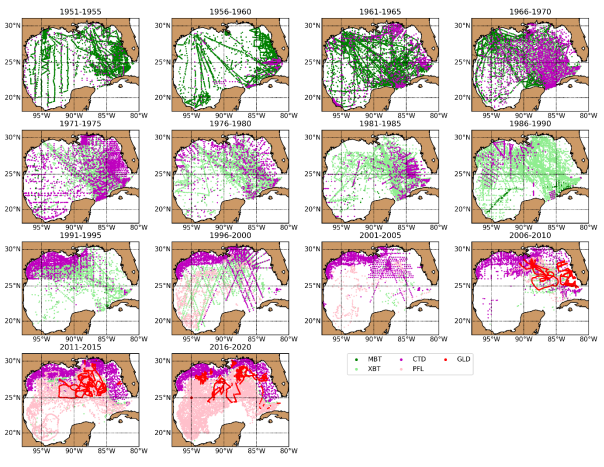NOAA-NCEI and NGI Researchers: Wang, Boyer, Reagan, and Hogan Publish Paper on Oceanic Warming with AMS
March 20, 2023

Fig. 1. Temperature profiles' spatial distribution for every pentadal (5-year) period from 1951 to 2020. The color shows different measurement types. MBT: mechanical bathythermograph (MBT) data, digital BT (DBT), and micro-BT (μBT); XBT: expendable bathythermograph and AXBT; CTD: bottle, Conductivity-Temperature-Depth (CTD), expendable CTD (XCTD) data; GLD: glider data; PFL: profiling float data, mainly from the Argo program. Some of the data points may not be shown due to data overlap.
Researchers from NOAA-NCEI recently published a paper on Oceanic Warming with AMS. Researchers include Zhankun Wang with NOAA's National Centers for Environmental Information and Northern Gulf Institute, Tim Boyer with NOAA's National Centers for Environmental Information, James Reagan with NOAA's National Centers for Environmental Information, and Patrick Hogan with Northern Gulf Institute.
Abstract
We estimate ocean heat content (OHC) change in the upper 2000 m in the Gulf of Mexico (GOM) from 1950 to 2020 to improve understanding of regional warming. Our estimates are based on 192,890 temperature profiles from the World Ocean Database. Warming occurs at all depths and in most regions except for a small region at northeastern GOM between 200 and 600m. GOM OHC in the upper 2000m increases at a rate of 0.38±0.13 ZJ decade
-1 between 1970 and 2020, which is equivalent to 1.21±0.41 TeraWatts (TW). The GOM sea surface temperature (SST) increased ~1.0±0.25 °C between 1970 and 2020, equivalent to a warming rate of 0.19±0.05 °C decade
-1. Although SST in the GOM increases at a rate approximately twice that for the global ocean, the full-depth ocean heat storage rate in the GOM (0.86±0.26 W m
-2) applied to the entire GOM surface is comparable to that for the global ocean (0.82 to 1.11 W m
-2). The upper 1000m layer accounts for approximately 80- 90% of the total warming and variations in the upper 2000m in the GOM. The Loop Current advective net heat flux is estimated to be 40.7±6.3 TW through the GOM. A heat budget analysis shows the difference between the advective heat flux and the ocean heat storage rate (1.76±1.36 TW, 1992-2017) can be roughly balanced with the annual net surface heat flux from ECCO (-37.9 TW).
View Full Paper Here: Upper Oceanic Warming in the Gulf of Mexico between 1950 and 2020
